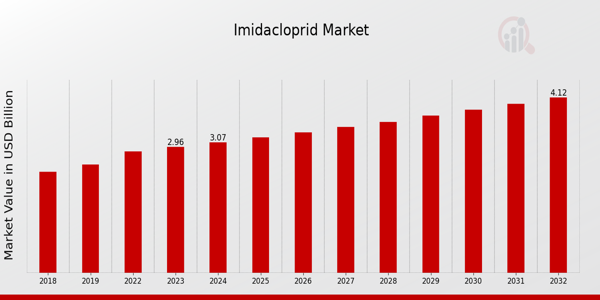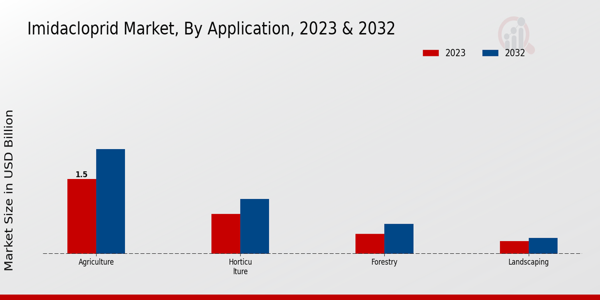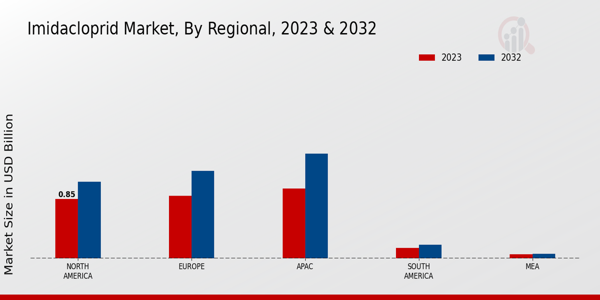Global Imidacloprid Market Overview
The Imidacloprid Market Size was estimated at 3.18 (USD Billion) in 2024.The Imidacloprid Industry is expected to grow from 3.30 (USD Billion) in 2025 to 4.61 (USD Billion) by 2034. The Imidacloprid Market CAGR (growth rate) is expected to be around 3.76% during the forecast period (2025 - 2034).
Key Imidacloprid Market Trends Highlighted
The Imidacloprid Market share is on the rise and there are a number of factors for this, including the demand for advanced pest control in the agricultural sector. Due to the considerable impact that imidacloprid has on a larger number of pests and increased yields, farmers are using it more. In addition, the advancement of environmentally friendly agriculture increases the demand for such solutions that would control pest populations while being safe for the environment. The rising trend of organic farming also boosts demand for less harmful pesticides and enhances the market. The imidacloprid market has a lot to offer in terms of unexplored opportunities. Advancements in different formulations and delivery systems will be able to meet the needs of new customers looking for effective and more precise pest control measures.Also, entering new markets with growing agriculture can be fruitful for the manufacturers. Partnerships with biotechnological companies may help evolve new formulations that would improve imidacloprid performance and satisfy farmers' constantly evolving needs. In addition, the growing tendency toward integrated pest management (IPM) systems is consistent with the role of imidacloprid in sustainable agriculture. Nowadays, there has been a tendency for consumers' preferences to change in view of the shift towards more sustainable agricultural practices. There is an increasing market for crops that do not leave residues, and this requires manufacturers to improve their products' safety.The imidacloprid market is experiencing significant growth driven by the increasing demand for effective pest control in agriculture. Farmers are increasingly adopting imidacloprid due to its efficacy against a wide range of pests and its contribution to higher crop yields. Moreover, the need for sustainable agricultural practices is fueling the search for solutions that balance pest management with environmental safety.
The rise in organic farming also encourages the use of safer pesticides, further promoting the market. There are numerous opportunities to be explored in the imidacloprid market. Innovations in formulations and delivery mechanisms can attract new customers seeking more efficient and targeted pest control methods.Additionally, expanding into emerging markets with growing agricultural sectors presents a significant opportunity for manufacturers. Collaborations with biotechnology firms may lead to the development of new products that enhance imidacloprid's effectiveness, meeting the evolving needs of farmers. Further, the increasing trend of integrated pest management (IPM) strategies aligns with the use of imidacloprid as a key component in sustainable farming practices. Recent times have seen a shift towards more environmentally friendly agricultural practices, which has led to changes in consumer preferences. The demand for residue-free crops is on the rise, urging manufacturers to innovate and improve the safety profiles of their products.There has also been an increase in research and development aimed at creating alternatives and complementary products that work alongside imidacloprid. Additionally, regulatory trends are becoming more stringent, making it crucial for manufacturers to stay informed and adapt to these changes while developing their products to ensure compliance and safety in the market.
Source: Primary Research, Secondary Research, MRFR Database and Analyst Review
Imidacloprid Market Drivers
Increasing Demand for Pest Control Solutions
The Imidacloprid Market Industry is witnessing a significant surge in demand for effective pest control solutions across various agricultural sectors. This increase is driven by the growing need to enhance crop yields and quality, which is paramount for meeting the rising food demand. As the population continues to grow, the agricultural sector is under pressure to produce more food efficiently while minimizing losses from pests that can damage crops.Imidacloprid, being a systemic insecticide that delivers effective control against a wide range of harmful insects, has gained popularity among farmers and agricultural producers. Its effectiveness, coupled with a moderate environmental footprint, makes it a preferred choice in pest management practices. With advancements in agricultural methodologies, including precision farming, the application of imidacloprid is expected to become more targeted and efficient.Furthermore, the awareness and education about integrated pest management (IPM) practices, where imidacloprid can play a crucial role, are also contributing to its increased adoption. The combination of these factors contributes to the overall expansion of the Imidacloprid Market, creating a promising outlook for manufacturers and stakeholders in the agriculture industry.
Technological Advancements in Formulation
The Imidacloprid Market Industry is being propelled forward by continuous technological advancements in the formulation and delivery of imidacloprid productsContinuous technological advancements in the formulation and delivery of imidacloprid products are propelling forward the Imidacloprid Market Industry. Innovations in formulation technologies have led to the development of more efficient and effective products that offer improved solubility, stability, and application methods. The introduction of slow-release formulations and nano-encapsulated products enhances the efficacy of imidacloprid while reducing the frequency of application required by farmers.This not only makes pest control more effective but also minimizes the environmental impact, aligning with the growing push for sustainable agricultural practices. As manufacturers innovate to meet these requirements, the adoption of imidacloprid is expected to rise, contributing positively to market growth.
Growing Awareness of Sustainable Agriculture Practices
The Imidacloprid Market Industry is benefitting from the increasing awareness of sustainable agriculture practices. As focus shifts towards sustainable farming, practices that minimize environmental impact while maintaining productivity are gaining traction among farmers and agriculturalists. Imidacloprid, when used responsibly as part of integrated pest management, aligns with sustainable practices by effectively controlling pests while reducing the need for more harmful alternatives.Governments and regulatory bodies also support these initiatives by promoting the use of environmentally friendly agricultural chemicals, which drives further growth in the imidacloprid market.
Imidacloprid Market Segment Insights
Imidacloprid Market Application Insights
The Application segment of the Imidacloprid Market is a vital area encompassing various sectors that significantly contribute to overall market dynamics. In 2023, the market is valued at approximately 2.96 USD Billion, with agriculture being the most significant contributor, holding a revenue of 1.5 USD Billion. This dominance underscores the critical role of Imidacloprid in crop protection, enabling enhanced agricultural yield and pest control, thus directly influencing food production efficiency. Following agriculture, the horticulture segment also plays an important role, with a valuation of 0.8 USD Billion in 2023.The growth in horticulture can be attributed to increasing consumer demand for ornamental plants and vegetables, which necessitates effective pest management solutions like Imidacloprid to ensure healthy crop growth and sustain industry demands. The forestry segment, valued at 0.4 USD Billion in 2023, highlights the importance of protecting timber resources from various pests that threaten forest health. This segment's value illustrates growing awareness regarding pest management in forestry practices, which can lead to improved sustainability and forest productivity.Finally, the landscaping segment, though smaller with a valuation of 0.26 USD Billion in 2023, is noteworthy for its potential growth as urbanization increases and the aesthetic appeal of well-maintained landscapes becomes more desirable. Each of these segments contributes uniquely to the overall Imidacloprid Market revenue, driven by trends such as environmental sustainability and the need for effective pest management solutions across diverse agricultural and horticultural practices. Collectively, they reflect a growing recognition of Imidacloprid's role in enhancing production efficiencies and environmental health, indicating substantial opportunities for future growth in several application sectors.
Source: Primary Research, Secondary Research, MRFR Database and Analyst Review
Imidacloprid Market Crop Type Insights
The Imidacloprid Market has shown a steady growth trajectory, with a projected valuation of 2.96 billion USD in 2023. A significant portion of this market is attributed to the Crop Type segment, which includes various categories such as Field Crops, Fruit Crops, Vegetable Crops, and Ornamental Plants. Field Crops dominate this market due to their extensive application in agriculture and widespread cultivation, making them crucial for food security. Fruit Crops represent another vital area, as they cater to the growing demand for organic produce.Vegetable Crops also play an important role, as the rising population drives the need for enhanced agricultural productivity and pest management. Ornamental Plants, though a smaller segment, are significant for the landscaping and horticulture industries, contributing to market diversity. Overall, the Imidacloprid Market data reveals that crop type segmentation fosters opportunities for innovation in pest management solutions, driven by trends towards sustainable agriculture and increasing yields, although challenges remain with regulatory measures and environmental concerns.As the market continues to evolve, each crop type presents unique opportunities for growth and adaptation within the Imidacloprid Market industry.
Imidacloprid Market Formulation Type Insights
The Imidacloprid Market revenue is shaped significantly by the formulation type, which comprises categories such as Granular, Liquid, Wettable Powder, and Emulsifiable Concentrate. Each formulation type offers unique characteristics that cater to diverse agricultural needs. For instance, Granular formulations are favored for their ease of application and long residual activity, making them suitable for soil treatment. Conversely, Liquid formulations are often chosen for their rapid efficacy and versatility in various settings. Wettable Powders are crucial for their flexibility in application methods, providing options for both spraying and mixing, while Emulsifiable Concentrates are known for their effectiveness in controlling various pests.The Imidacloprid Market segmentation reflects the growing demand for different formulations tailored to specific agricultural practices. Market growth in this segment is driven by factors like rising pest resistance and the need for sustainable agriculture solutionsFactors like rising pest resistance and the need for sustainable agriculture solutions drive market growth in this segment. However, challenges such as regulatory scrutiny and environmental concerns impact the market dynamics. For the period leading up to 2032, significant opportunities exist in expanding the application of these formulations amid increasing food production demands, highlighting the critical role of formulation type in the overall strategy of the Imidacloprid Market industry.
Imidacloprid Market Distribution Channel Insights
The Imidacloprid Market, with a projected revenue of 2.96 billion USD in 2023, highlights various distribution channels that play a critical role in the market's overall dynamics. The distribution channels are pivotal as they determine accessibility and convenience for end-users. Online platforms have gained traction due to increasing digitalization and changing consumer behavior, making them a significant channel for buyers seeking easy access. Retail outlets continue to serve as a traditional source, allowing consumers to physically assess products before purchasing.Wholesale channels facilitate bulk buying, which is crucial for larger agricultural enterprises, enhancing supply chain efficiency. Direct sales are also pertinent, providing opportunities for manufacturers to engage directly with customers, ensuring tailored solutions and better feedback while optimizing sales. Together, these channels not only provide varied purchasing options but also cater to the diverse needs of customers in the Imidacloprid Market, underpinning growth and expansion in an evolving industry landscape. The market statistics indicate a healthy growth environment where each distribution channel presents unique opportunities and challenges to fuel the overall growth trajectory.
Imidacloprid Market Regional Insights
The Imidacloprid Market is valued at 2.96 USD Billion in 2023, with various regional segments contributing significantly to its growth. North America holds a substantial share, valued at 0.85 USD Billion, reflecting its importance in agricultural practices and pest management solutions, projected to reach 1.1 USD Billion by 2032. Europe closely follows, with a valuation of 0.9 USD Billion in 2023, as it focuses on advanced farming techniques and regulations around pesticide use, expected to grow to 1.25 USD Billion. The APAC region leads in market growth, valued at 1.0 USD Billion, driven by increasing agricultural productivity demands and reaching 1.5 USD Billion by 2032, showcasing its major role in feeding the population.Meanwhile, South America and MEA show smaller but noteworthy contributions, standing at 0.15 USD Billion and 0.06 USD Billion, respectively, in 2023, progressing to 0.2 USD Billion and 0.07 USD Billion by 2032. Overall, the regional dynamics highlight areas of significant growth and the varying importance of Imidacloprid in addressing agricultural challenges across different market segments.
Source: Primary Research, Secondary Research, MRFR Database and Analyst Review
Imidacloprid Market Key Players and Competitive Insights
The Imidacloprid Market has witnessed significant growth and transformation, shaped by a myriad of competitive factors. The market, which focuses on the production and distribution of imidacloprid, a widely used neonicotinoid insecticide, features strong competition among various stakeholders, including chemical manufacturers, agricultural product suppliers, and distributors who cater to the agricultural sector. The landscape is characterized by strategic partnerships, collaborations, and potential mergers and acquisitions that aid companies in bolstering their market position. Factors such as technological advancements, regulatory policies, and environmental concerns also play a crucial role in shaping competitive strategies within the market. Companies within this space are constantly innovating to develop products that align with sustainable agricultural practices while responding to the evolving needs of farmers and the community at large.Bayer stands as a dominant player in the Imidacloprid Market, renowned for its robust product portfolio and commitment to innovation in crop protection. The company leverages its extensive research and development capabilities to enhance the efficacy of its imidacloprid offerings while ensuring compliance with stringent regulatory standards. Bayer's strong distribution network and strategic market presence facilitate accessibility to its products, making them it a preferred choice among farmers worldwide. The company’s company's focus on sustainability and integrated pest management practices also resonates well with the growing demand for environmentally friendly agricultural solutions. With continuous investment in new technologies and an emphasis on customer support and education, Bayer effectively maintains a competitive edge in this dynamic market.Sumitomo Chemical has carved a notable presence in the Imidacloprid Market, driven by its vision of creating value through innovation and sustainability. The company is recognized for its strong manufacturing capabilities and commitment to developing high-quality products that meet the diverse needs of agricultural stakeholders. Sumitomo Chemical places a strong emphasis on research and development, which allows it to improve the performance of its imidacloprid formulations and address the challenges posed by pests effectively. The company’s company's strategic approach includes partnerships with local distributors and agribusinesses, enhancing its market penetration and fostering strong relationships within the agricultural community. This blend of innovation and collaboration positions Sumitomo Chemical as a key player in this competitive landscape, enabling it to respond adeptly to market demands while aligning with sustainable agricultural practices.
Key Companies in the Imidacloprid Market Include
Imidacloprid Market Industry Developments
The Imidacloprid Market has witnessed several significant developments recently. Bayer continues to lead the market through innovation, focusing on sustainable pest management solutions while addressing regulatory challenges. Sumitomo Chemical is expanding its production capabilities in response to rising demand, particularly in the Asia-Pacific region. Lanxess announced strategic investments to enhance its crop protection product line, which is projected to drive their its market share. Furthermore, Corteva Agriscience has been actively pursuing partnerships to enhance integrated pest management practices globally. Notably, UPL Limited has seen substantial growth in its revenue attributed to its diverse portfolio, while FMC Corporation has been focusing on new formulations for enhanced efficacy and safety. Recent acquisition activities include Nufarm seeking to enhance its position in the market through targeted acquisitions, which aligns with its growth strategy. With the increasing emphasis on sustainable agricultural practices, companies like ADAMA Agricultural Solutions and Jiangshan Chemical are revolutionizing their approaches to pesticide formulation. The overall market valuation for these companies is on the rise, driven by heightened demand for environmentally friendly pest control options and regulatory compliance advancements in various regions.
Imidacloprid Market Segmentation Insights
Imidacloprid Market Application Outlook
-
Agriculture
-
Horticulture
-
Forestry
-
Landscaping
Imidacloprid Market Crop Type Outlook
-
Field Crops
-
Fruit Crops
-
Vegetable Crops
-
Ornamental Plants
Imidacloprid Market Formulation Type Outlook
-
Granular
-
Liquid
-
Wettable Powder
-
Emulsifiable Concentrate
Imidacloprid Market Distribution Channel Outlook
-
Online
-
Retail
-
Wholesale
-
Direct Sales
Imidacloprid Market Regional Outlook
-
North America
-
Europe
-
South America
-
Asia Asia-Pacific
| Report Attribute/Metric |
Details |
| Market Size 2024 |
3.18 (USD Billion) |
| Market Size 2025 |
3.30 (USD Billion) |
| Market Size 2034 |
4.61 (USD Billion) |
| Compound Annual Growth Rate (CAGR) |
3.76% (2025- 2034) |
| Report Coverage |
Revenue Forecast, Competitive Landscape, Growth Factors, and Trends |
| Base Year |
2024 |
| Market Forecast Period |
2025- 2034 |
| Historical Data |
2020 - 2024 |
| Market Forecast Units |
USD Billion |
| Key Companies Profiled |
Bayer, Sumitomo Chemical, Lanxess, Hanfeng Evergreen, Corteva Agriscience, Nufarm, Chemchina, Nihon Nohyaku, Jiangshan Chemical, Guangdong Techand, ADAMA Agricultural Solutions, Wynca Chemical, UPL Limited, Syngenta, FMC Corporation |
| Segments Covered |
Application, Crop Type, Formulation Type, Distribution Channel, Regional |
| Key Market Opportunities |
Rising demand for organic farming, Expanding agricultural practices in developing regions, Increasing awareness of pest resistance, Technological advancements in pesticide formulations, Growth in companion animal care products |
| Key Market Dynamics |
Increasing demand for pest control, Regulatory challenges and compliance, Growing awareness of sustainable agriculture, Expansion of agricultural practices, Competition from alternative pesticides |
| Countries Covered |
North America, Europe, APAC, South America, MEA |
Frequently Asked Questions (FAQ) :
The Imidacloprid Market is expected to be valued at 4.61 USD Billion in 2034.
The Imidacloprid Market is expected to grow at a CAGR of 3.76% from 2025 to 2034.
The Agriculture application segment is projected to reach a value of 2.1 USD Billion in 2032.
The Imidacloprid Market in North America is expected to be valued at 1.1 USD Billion in 2032.
Major players in the market include Bayer, Sumitomo Chemical, Lanxess, and Corteva Agriscience.
The Horticulture application segment is expected to be valued at 1.1 USD Billion in 2032.
The Forestry application segment is projected to reach a value of 0.6 USD Billion in 2032.
The Landscaping application is expected to be valued at 0.32 USD Billion in 2032.
The APAC region is expected to have a market size of 1.5 USD Billion in 2032.
The market value for South America is projected to be 0.2 USD Billion in 2032.

















